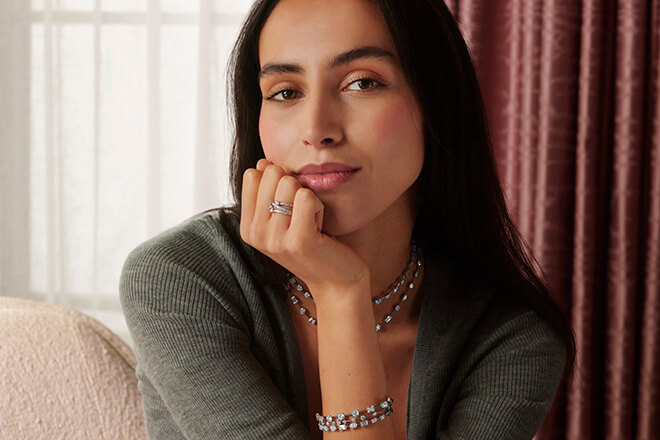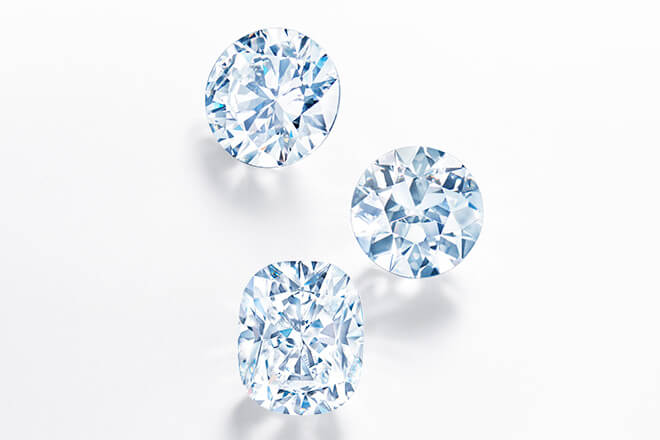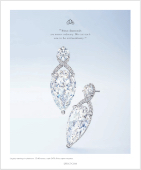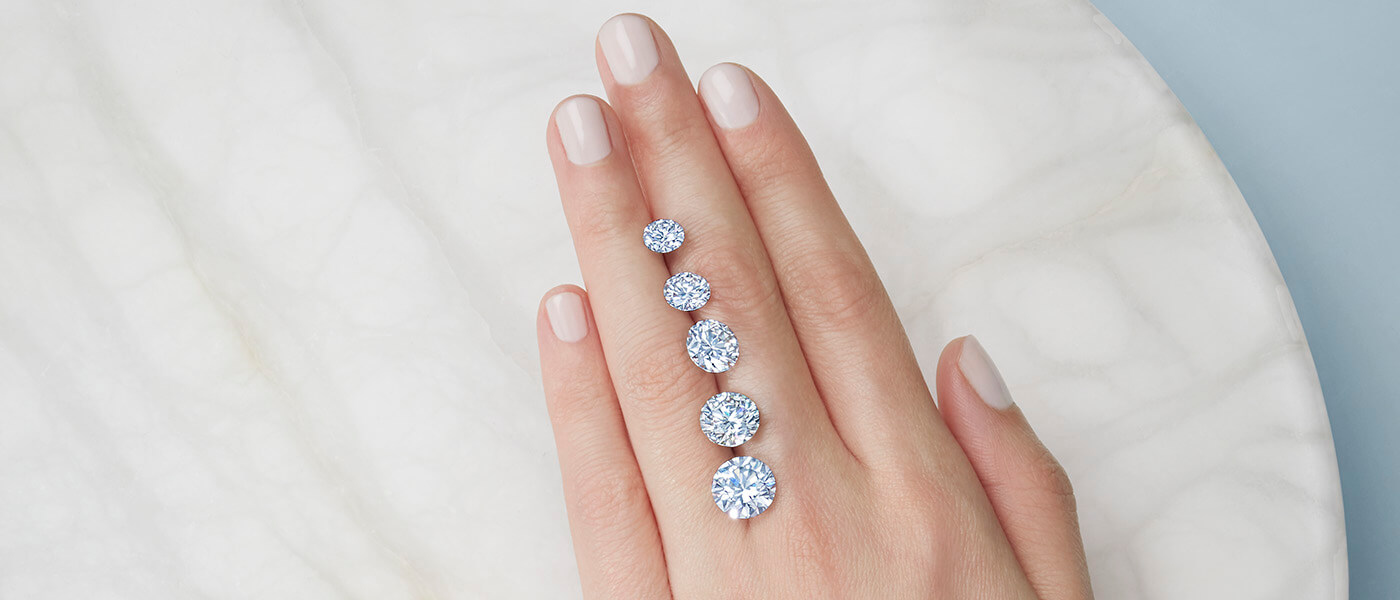DIAMOND CARAT
One of the easiest terms to understand is a diamond’s carat. Simply put, carat is the weight of a gemstone or diamond on a gem scale.
The 4Cs – Diamond Carat Weight
Carat is often the first thing to come to mind when thinking about a diamond’s size. Size and carat weight are closely related but there are other factors in a diamond’s appearance. Cut and shape also play a role in whether the diamond appears visually larger or smaller than its actual carat weight.
ORIGIN OF CARAT
“Carat” comes from the word “carob”—a small tree in the Middle East with edible pods. Prior to the modern measurement system, gemstones and diamonds were weighed using the small, lightweight seeds from carob pods to counterbalance the scales. Since then, one carat has been standardized and is now equal to 200 mg.
The 4Cs – Carat vs. Karat
CARAT OR KARAT?
Both are used to assess the value of jewelry. Carat is the weight of a diamond. Karat, on the other hand, measures the purity of gold.
-
 123456
123456Engagement Ring with a Kwiat Round ...
18K Rose Gold |
Select options -
 123
123Engagement Ring with a Round Brilli...
18K Yellow Gold
Select options -
 123
123Engagement Ring with a Round Brilli...
Platinum
Select options -
 123
123Engagement Ring with an Ashoka Diam...
Platinum
Select options -
 123
123Kwiat Cushion™ Diamond Engagement R...
Platinum
Select options -
 12345
12345Engagement Ring with a Kwiat Round ...
Platinum
Select options -
 1234
1234Engagement Ring with a Kwiat Emeral...
Platinum
Select options -
 1234
1234Engagement Ring with a Kwiat Oval D...
Platinum |
Select options -
 123
123Engagement Ring with a Kwiat Radian...
Platinum
Select options -
 1234
1234Engagement Ring with a Round Brilli...
18K Yellow Gold
Select options -
 123
123Engagement Ring with a Round Brilli...
Platinum
Select options -
 123
123Engagement Ring with an Ashoka Diam...
Platinum
Select options -
 123
123Engagement Ring with an East-West O...
18K Rose Gold
Select options -
 1234
1234Kwiat Cushion™ Diamond Engagement R...
18K Yellow Gold
Select options -
 123
123Kwiat Cushion™ Diamond Engagement R...
Platinum
Select options -
 1234
1234Engagement Ring with a Round Brilli...
Platinum
Select options -
 123
123Engagement Ring with an Ashoka Diam...
Platinum
Select options -
 123
123Engagement Ring with an Emerald Cut...
Platinum
Select options -
 123
123Engagement Ring with an Oval Diamon...
Platinum
Select options -
 123
123Engagement Ring with an Oval Diamon...
Platinum and 18K Yellow Gold
Select options -
 123
123Oval Diamond Engagement Ring with T...
Platinum
Select options -
 1234
1234ASHOKA® Diamond Engagement Ring wit...
Platinum
Select options -
 123
123Engagement Ring with a Compass Set ...
Platinum
Select options -
 123
123Engagement Ring with a Kwiat Cushio...
18K Rose Gold
Select options -
 123
123Engagement Ring with a Kwiat Cushio...
Platinum
Select options -
 123
123Engagement Ring with a Kwiat Cushio...
Platinum
Select options -
 123
123Engagement Ring with a Kwiat Emeral...
Platinum
Select options -
 123
123Engagement Ring with a Kwiat Oval D...
Platinum
Select options -
 123
123Engagement Ring with a Kwiat Round ...
Platinum
Select options -
 123
123Engagement Ring with a Kwiat Round ...
Platinum
Select options -
 1234
1234Engagement Ring with a Round Brilli...
18K Yellow Gold
Select options -
 123
123Engagement Ring with an Ashoka Diam...
Platinum
Select options -
 1234
1234Kwiat Cushion™ Diamond Engagement R...
18K Rose Gold
Select options -
 1234
1234Oval Diamond Engagement Ring with a...
18K Rose Gold
Select options -
 123
123Oval Diamond Engagement Ring with P...
Platinum
Select options -
 12
12Engagement Ring with a Radiant Diam...
Platinum
Select options -
 1234
1234Engagement Ring with Emerald Cut Di...
Platinum
Select options -
 123456
123456Engagement Ring with Three Ashoka D...
Platinum |
Select options -
 123
123Engagement Ring with a Round Brilli...
Platinum
Select options -
 1234
1234Engagement Ring with a Round Brilli...
Platinum
Select options -
 123
123Engagement Ring with an Ashoka Diam...
Platinum
Select options -
 123
123Engagement Ring with a Kwiat Cushio...
Platinum
Select options -
 123
123Engagement Ring with a Kwiat Oval D...
Platinum
Select options -
 1234
1234Engagement Ring with an Ashoka Diam...
Platinum
Select options -
 12
12Engagement Ring with an Oval Diamon...
Platinum
Select options -
 12
12Vintage Style Engagement Ring with ...
Platinum
Select options -
 123
123East-West Emerald Cut Diamond Engag...
18K Rose Gold
Select options -
 123
123East-West Emerald Cut Diamond Engag...
18K Yellow Gold
Select options -
 123
123East-West Emerald Cut Diamond Engag...
Platinum
Select options -
 123
123East-West Kwiat Cushion™ Diamond En...
18K Rose Gold
Select options -
 123
123East-West Kwiat Cushion™ Diamond En...
18K Yellow Gold
Select options -
 123
123East-West Kwiat Cushion™ Diamond En...
Platinum
Select options -
 123
123East-West Oval Diamond Engagement R...
18K Rose Gold
Select options -
 123
123East-West Oval Diamond Engagement R...
Platinum
Select options -
 123
123Emerald Cut Diamond Engagement Ring...
18K Rose Gold
Select options -
 123
123Emerald Cut Diamond Engagement Ring...
18K Yellow Gold
Select options -
 123
123Emerald Cut Diamond Engagement Ring...
Platinum
Select options -
 123
123Engagement Ring with a Fred Leighto...
18K Rose Gold
Select options -
 123
123Engagement Ring with a Fred Leighto...
18K Yellow Gold
Select options -
 123
123Engagement Ring with a Fred Leighto...
Platinum
Select options -
 123
123Engagement Ring with a Kwiat Radian...
18K Rose Gold
Select options -
 123
123Engagement Ring with a Kwiat Radian...
18K Yellow Gold
Select options -
 123
123Engagement Ring with a Kwiat Radian...
Platinum
Select options -
 123
123Engagement Ring with an Ashoka Diam...
18K Rose Gold
Select options -
 123
123Engagement Ring with an Ashoka Diam...
18K Yellow Gold
Select options -
 123
123Engagement Ring with an East-West A...
18K Rose Gold
Select options -
 123
123Engagement Ring with an East-West A...
18K Yellow Gold
Select options -
 123
123Engagement Ring with an East-West A...
Platinum
Select options -
 123
123Engagement Ring with an East-West K...
18K Rose Gold
Select options -
 123
123Engagement Ring with an East-West K...
18K Yellow Gold
Select options -
 123
123Engagement Ring with an East-West K...
Platinum
Select options -
 123
123Engagement Ring with an East-West ...
18K Yellow Gold
Select options -
 123
123Engagement Ring with an Oval Diamon...
18K Rose Gold
Select options -
 123
123Engagement Ring with an Oval Diamon...
18K Yellow Gold
Select options -
 123
123Engagement Ring with an Oval Diamon...
Platinum
Select options -
 123
123Kwiat Cushion™ Diamond Engagement R...
18K Rose Gold
Select options -
 123
123Kwiat Cushion™ Diamond Engagement R...
18K Yellow Gold
Select options -
 123
123Engagement Ring with a Bezel Set Ro...
18K Rose Gold
Select options -
 123
123Engagement Ring with a Bezel Set Ro...
18K Yellow Gold
Select options -
 123
123Engagement Ring with a Bezel Set Ro...
Platinum
Select options -
 1234
1234Engagement Ring with a Round Brilli...
18K Rose Gold
Select options -
 1234
1234Engagement Ring with a Round Brilli...
18K Yellow Gold
Select options -

Engagement Ring with an Oval Diamon...
18K Rose Gold
Select options -

Engagement Ring with an Oval Diamon...
18K Yellow Gold
Select options -
 123
123Engagement Ring with an Oval Diamon...
Platinum
Select options -
 123
123East-West Emerald Cut Diamond Engag...
18K Rose Gold
Select options -
 123
123East-West Emerald Cut Diamond Engag...
18K Yellow Gold
Select options -
 123
123East-West Emerald Cut Diamond Engag...
Platinum
Select options -
 123
123Engagement Ring with an East-West K...
18K Rose Gold
Select options -
 123
123Engagement Ring with a Fred Leighto...
18K Rose Gold
Select options -
 123
123Engagement Ring with a Fred Leighto...
18K Yellow Gold
Select options -
 123
123Engagement Ring with a Fred Leighto...
Platinum
Select options -
 1234
1234Engagement Ring with a Kwiat Emeral...
18K Rose Gold
Select options -
 1234
1234Engagement Ring with a Kwiat Emeral...
18K Yellow Gold
Select options -
 1234
1234Engagement Ring with a Kwiat Radian...
18K Rose Gold
Select options -
 1234
1234Engagement Ring with a Kwiat Radian...
18K Yellow Gold
Select options -
 1234
1234Engagement Ring with a Round Brilli...
18K Rose Gold
Select options -
 123
123Engagement Ring with an Ashoka Diam...
18K Rose Gold
Select options -
 123
123Engagement Ring with an Ashoka Diam...
18K Yellow Gold
Select options -
 123
123Engagement Ring with an East-West A...
18K Rose Gold
Select options -
 123
123Engagement Ring with an East-West A...
18K Yellow Gold
Select options -
 123
123Engagement Ring with an East-West A...
Platinum
Select options -
 123
123Engagement Ring with an East-West K...
18K Yellow Gold
Select options -
 123
123Engagement Ring with an East-West K...
Platinum
Select options -
 123
123Engagement Ring with an East-West K...
18K Rose Gold
Select options -
 123
123Engagement Ring with an East-West K...
18K Yellow Gold
Select options -
 123
123Engagement Ring with an East-West K...
Platinum
Select options -
 123
123Engagement Ring with an East-West O...
18K Yellow Gold
Select options -
 123
123Engagement Ring with an East-West O...
Platinum
Select options -
 1234
1234Kwiat Cushion™ Diamond Engagement R...
18K Rose Gold
Select options -
 1234
1234Oval Diamond Engagement Ring
18K Rose Gold
Select options -
 1234
1234Oval Diamond Engagement Ring
18K Yellow Gold
Select options -
 123
123Engagement Ring with a Kwiat Radian...
Platinum
Select options -
 123
123Engagement Ring with a Round Brilli...
18K Yellow Gold
Select options -
 123
123Engagement Ring with a Round Brilli...
Platinum
Select options -
 1234
1234Kwiat Cushion™ Diamond Engagement R...
Platinum
Select options -
 123
123East-West Emerald Cut Diamond Engag...
18K Rose Gold
Select options -
 123
123East-West Emerald Cut Diamond Engag...
18K Yellow Gold
Select options -
 123
123East-West Emerald Cut Diamond Engag...
Platinum
Select options -
 123
123East-West Kwiat Cushion™ Diamond En...
18K Rose Gold
Select options -
 123
123East-West Kwiat Cushion™ Diamond En...
18K Yellow Gold
Select options -
 123
123East-West Kwiat Cushion™ Diamond En...
18K Rose Gold
Select options -
 123
123East-West Kwiat Cushion™ Diamond En...
18K Yellow Gold
Select options -
 123
123East-West Kwiat Cushion™ Diamond En...
Platinum
Select options -
 123
123Engagement Ring with an East-West O...
18K Rose Gold
Select options -
 123
123Engagement Ring with an East-West O...
18K Yellow Gold
Select options -
 123
123East-West Radiant Cut Diamond Engag...
18K Rose Gold
Select options -
 123
123East-West Radiant Cut Diamond Engag...
18K Yellow Gold
Select options -
 123
123East-West Radiant Cut Diamond Engag...
Platinum
Select options -
 123
123Emerald Cut Diamond Engagement Ring...
18K Rose Gold
Select options -
 123
123Emerald Cut Diamond Engagement Ring...
18K Yellow Gold
Select options -
 123
123Emerald Cut Diamond Engagement Ring...
18K Rose Gold
Select options -
 123
123Emerald Cut Diamond Engagement Ring...
18K Yellow Gold
Select options -
 123
123Engagement Ring with a Fred Leighto...
18K Yellow Gold
Select options -
 123
123Engagement Ring with a Fred Leighto...
Platinum
Select options -
 123
123Engagement Ring with a Fred Leighto...
18K Rose Gold
Select options -
 123
123Engagement Ring with a Fred Leighto...
18K Rose Gold
Select options -
 123
123Engagement Ring with a Fred Leighto...
18K Yellow Gold
Select options -
 123
123Engagement Ring with a Fred Leighto...
Platinum
Select options -
 1234
1234Engagement Ring with a Kwiat Cushio...
18K Yellow Gold
Select options -
 123
123Engagement Ring with a Kwiat Emeral...
Platinum
Select options -
 123
123Engagement Ring with a Kwiat Radian...
Platinum
Select options -
 123
123Engagement Ring with a Kwiat Round ...
Platinum
Select options -
 1234
1234Engagement Ring with a Round Brilli...
18K Rose Gold
Select options -
 1234
1234Engagement Ring with a Round Brilli...
18K Rose Gold
Select options -
 1234
1234Engagement Ring with a Round Brilli...
18K Yellow Gold
Select options -
 123
123Engagement Ring with an Ashoka Diam...
18K Rose Gold
Select options -
 1234
1234Engagement Ring with an Ashoka Diam...
18K Rose Gold
Select options -
 123
123Engagement Ring with an Ashoka Diam...
18K Yellow Gold
Select options -
 1234
1234Engagement Ring with an Ashoka Diam...
18K Yellow Gold
Select options -
 123
123Engagement Ring with an East-West A...
18K Rose Gold
Select options -
 123
123Engagement Ring with an East-West A...
18K Yellow Gold
Select options -
 123
123Engagement Ring with an East-West A...
Platinum
Select options -
 123
123Engagement Ring with an East-West A...
18K Rose Gold
Select options -
 123
123Engagement Ring with an East-West A...
18K Yellow Gold
Select options -
 123
123Engagement Ring with an East-West A...
Platinum
Select options -
 123
123Engagement Ring with an East-West E...
18K Rose Gold
Select options -
 123
123Engagement Ring with an East-West E...
18K Yellow Gold
Select options -
 123
123Engagement Ring with an East-West E...
Platinum
Select options -
 123
123Engagement Ring with an East-West K...
Platinum
Select options -
 123
123Engagement Ring with an East-West K...
18K Rose Gold
Select options -
 123
123Engagement Ring with an East-West K...
18K Yellow Gold
Select options -
 123
123Engagement Ring with an East-West K...
Platinum
Select options -
 123
123Engagement Ring with an East-West O...
18K Rose Gold
Select options -
 123
123Engagement Ring with an East-West O...
18K Yellow Gold
Select options -
 123
123Engagement Ring with an East-West O...
Platinum
Select options -
 123
123Engagement Ring with an East-West O...
Platinum
Select options -
 1234
1234Kwiat Cushion™ Diamond Engagement R...
18K Yellow Gold
Select options -
 1234
1234Oval Diamond Engagement Ring with a...
18K Yellow Gold
Select options -
 1234
1234Oval Diamond Engagement Ring with P...
18K Rose Gold
Select options -
 1234
1234Oval Diamond Engagement Ring with P...
18K Yellow Gold
Select options -
 123
123Radiant Cut Diamond Engagement Ring...
18K Rose Gold
Select options -
 123
123Radiant Cut Diamond Engagement Ring...
18K Yellow Gold
Select options -
 1234
1234Radiant Cut Diamond Engagement Ring...
18K Rose Gold
Select options -
 1234
1234Radiant Cut Diamond Engagement Ring...
18K Yellow Gold
Select options -
 1234
1234Radiant Cut Diamond Engagement Ring...
Platinum
Select options -
 123
123Engagement Ring with a Fred Leighto...
18K Rose Gold
Select options -
 123
123Engagement Ring with a Fred Leighto...
Platinum
Select options -
 123
123Engagement Ring with a Fred Leighto...
18K Yellow Gold
Select options -
 123
123Engagement Ring with a Kwiat Cushio...
18K Rose Gold
Select options -
 123
123Engagement Ring with a Kwiat Cushio...
18K Yellow Gold
Select options -
 123
123Engagement Ring with a Kwiat Cushio...
18K Rose Gold
Select options -
 123
123Engagement Ring with a Kwiat Cushio...
Platinum
Select options -
 123
123Engagement Ring with a Kwiat Cushio...
18K Yellow Gold
Select options -
 123
123Engagement Ring with a Kwiat Cushio...
Platinum
Select options -
 123
123Engagement Ring with a Kwiat Oval D...
18K Rose Gold
Select options -
 123
123Engagement Ring with a Kwiat Oval D...
18K Yellow Gold
Select options -
 123
123Engagement Ring with a Kwiat Oval D...
Platinum
Select options -
 123
123Engagement Ring with a Kwiat Round ...
Platinum
Select options -
 123
123Engagement Ring with a Radiant Cut ...
18K Rose Gold
Select options -
 123
123Engagement Ring with a Radiant Cut ...
18K Yellow Gold
Select options -
 123
123Engagement Ring with a Radiant Cut ...
Platinum
Select options -
 123
123Engagement Ring with a Round Brilli...
18K Rose Gold
Select options -
 123
123Engagement Ring with a Round Brilli...
18K Yellow Gold
Select options -
 123
123Engagement Ring with a Round Brilli...
18K Rose Gold
Select options -
 123
123Engagement Ring with an Ashoka Diam...
18K Rose Gold
Select options -
 123
123Engagement Ring with an Ashoka Diam...
18K Yellow Gold
Select options -
 123
123Engagement Ring with Double Side St...
18K Rose Gold
Select options -
 123
123Engagement Ring with Double Side St...
18K Yellow Gold
Select options -
 123
123Engagement Ring with Double Side St...
Platinum
Select options -
 123
123Engagement Ring with a Pavé Split B...
18K Rose Gold
Select options -
 123
123Engagement Ring with a Pavé Split B...
18K Yellow Gold
Select options -
 123
123Engagement Ring with a Pavé Split B...
Platinum
Select options -
 123
123Engagement Ring with an Emerald Cut...
18K Rose Gold
Select options -
 123
123Engagement Ring with an Emerald Cut...
18K Yellow Gold
Select options -
 123
123Engagement Ring with an Emerald Cut...
18K Rose Gold
Select options -
 123
123Engagement Ring with an Emerald Cut...
18K Yellow Gold
Select options -
 123
123Engagement Ring with an Emerald Cut...
Platinum
Select options -
 123
123Engagement Ring with an Oval Diamon...
18K Rose Gold
Select options -
 123
123Engagement Ring with an Oval Diamon...
18K Yellow Gold
Select options -
 123
123Engagement Ring with an Oval Diamon...
Platinum
Select options -
 123
123Engagement Ring with an Oval Yellow...
Platinum
Select options -
 123
123Engagement Ring with ASHOKA® Diamon...
18K Rose Gold
Select options -
 123
123Engagement Ring with ASHOKA® Diamon...
18K Yellow Gold
Select options -
 1234
1234Engagement Ring with ASHOKA® Diamon...
Platinum
Select options -
 123
123Engagement Ring with Emerald Cut Di...
18K Rose Gold
Select options -
 123
123Engagement Ring with Emerald Cut Di...
18K Yellow Gold
Select options -
 123
123Engagement Ring with a Kwiat Cushio...
18K Yellow Gold
Select options -
 123
123Engagement Ring with a Kwiat Cushio...
Platinum
Select options -
 123
123Engagement Ring with a Kwiat Cushio...
18K Rose Gold
Select options -
 123
123Engagement Ring with a Kwiat Emeral...
18K Yellow Gold
Select options -
 123
123Engagement Ring with a Radiant Cut ...
18K Rose Gold
Select options -
 123
123Engagement Ring with a Radiant Cut ...
18K Yellow Gold
Select options -
 123
123Engagement Ring with a Radiant Cut ...
Platinum
Select options -
 1234
1234Engagement Ring with a Round Brilli...
18K Rose Gold
Select options -
 1234
1234Engagement Ring with a Round Brilli...
18K Yellow Gold
Select options -
 1234
1234Engagement Ring with a Round Brilli...
18K Rose Gold
Select options -
 1234
1234Engagement Ring with a Round Brilli...
18K Yellow Gold
Select options -
 123
123Engagement Ring with an ASHOKA® Dia...
18K Rose Gold
Select options -
 123
123Engagement Ring with an ASHOKA® Dia...
18K Yellow Gold
Select options -
 123
123Engagement Ring with an ASHOKA® Dia...
Platinum
Select options -
 123
123Engagement Ring with an Emerald Cut...
18K Rose Gold
Select options -
 123
123Engagement Ring with an Emerald Cut...
Platinum
Select options -
 123
123Engagement Ring with an Oval Diamon...
18K Rose Gold
Select options -
 123
123Engagement Ring with an Oval Diamon...
18K Yellow Gold
Select options -
 123
123Engagement Ring with an Oval Diamon...
Platinum
Select options -
 123
123Kwiat Cushion™ Diamond Engagement R...
18K Rose Gold
Select options -
 123
123Kwiat Cushion™ Diamond Engagement R...
18K Yellow Gold
Select options -
 123
123Oval Diamond Engagement Ring with T...
18K Rose Gold
Select options -
 123
123Oval Diamond Engagement Ring with T...
18K Yellow Gold
Select options -
 123
123Radiant Cut Diamond Engagement Ring...
18K Rose Gold
Select options -
 123
123Radiant Cut Diamond Engagement Ring...
18K Yellow Gold
Select options -
 123
123Engagement Ring with a Compass Set ...
18K Rose Gold
Select options -
 123
123Engagement Ring with a Compass Set ...
18K Yellow Gold
Select options -
 123
123Engagement Ring with a Kwiat Emeral...
18K Yellow Gold
Select options -
 123
123Engagement Ring with a Kwiat Emeral...
Platinum
Select options -
 123
123Engagement Ring with a Kwiat Oval D...
18K Rose Gold
Select options -
 123
123Engagement Ring with a Kwiat Radian...
18K Rose Gold
Select options -
 123
123Engagement Ring with a Kwiat Radian...
18K Yellow Gold
Select options -
 123
123Engagement Ring with a Kwiat Radian...
Platinum
Select options -
 123
123Engagement Ring with a Kwiat Round ...
18K Rose Gold
Select options -
 123
123Engagement Ring with a Kwiat Round ...
18K Yellow Gold
Select options -
 123
123Engagement Ring with a Round Brilli...
18K Rose Gold
Select options -
 123
123Engagement Ring with a Round Brilli...
18K Yellow Gold
Select options -
 123
123Engagement Ring with a Round Brilli...
Platinum
Select options -
 123
123The Kwiat Setting Engagement Ring w...
18K Rose Gold
Select options -
 123
123The Kwiat Setting Engagement Ring w...
18K Yellow Gold
Select options -
 123
123The Kwiat Setting Engagement Ring w...
Platinum
Select options -
 123
123Engagement Ring with an Emerald Cut...
18K Rose Gold
Select options -
 123
123Vintage Style Engagement Ring with ...
Platinum
Select options -
 1234
1234Vintage Style Engagement Ring with ...
Platinum
Select options -
 123
123Engagement Ring with a Cushion Diam...
Platinum
Select options -
 123
123Engagement Ring with a Radiant Diam...
Platinum
Select options -
 123
123Engagement Ring with a Radiant Yell...
Platinum and 18K Yellow Gold
Select options -
 12
12Engagement Ring with an Emerald Cut...
Platinum
Select options -
 123
123Engagement Ring with a Radiant Yell...
18K Yellow Gold
Select options -
 123456
123456Engagement Ring with a Kwiat Cushio...
Platinum |
Select options -
 12
12Diamond and Double Halo Ring
Platinum
Select options -
 12
12Engagement Ring with an Ashoka Diam...
18K Rose Gold
Select options -
 123
123Engagement Ring with Three Ashoka D...
Platinum
Select options -
 123
123Engagement Ring with a Kwiat Cushio...
Platinum
Select options -
 12345
12345The Kwiat Setting Engagement Ring w...
Platinum and 18K Yellow Gold
Select options -
 1234
1234Engagement Ring with a Round Diamon...
Platinum
Select options -
 1234
1234Engagement Ring with an East-West B...
18K Rose Gold
Select options -
 123
123Vintage Style Engagement Ring with ...
Platinum
Select options -
 1234
1234Vintage Style Ashoka Diamond Engage...
Platinum
Select options -
 1234
1234Vintage Style Engagement Ring with ...
Platinum
Select options -
 123
123Vintage Style Engagement Ring with ...
Platinum
Select options -
 123
123Engagement Ring with a Ruby Halo in...
Platinum
Select options -
 123
123Emerald Cut Diamond Engagement Ring...
Platinum
Select options -
 12
12Emerald Cut Diamond Engagement Ring...
18K Yellow Gold
Select options -
 123
123Engagement Ring with a Radiant Diam...
Platinum
Select options -
 1234
1234Engagement Ring with a Round Brilli...
18K Yellow Gold
Select options -
 1234
1234Engagement Ring with an Oval Diamon...
Platinum
Select options -
 1234
1234Engagement Ring with an Oval Yellow...
Platinum
Select options -
 12
12Engagement Ring with an Oval Diamon...
Platinum
Select options -
 1234
1234Diamond Engagement Ring with a Step...
Platinum
Select options -
 123
123Cushion Cut Diamond Engagement Ring...
Platinum
Select options -
 12
12Emerald Cut Diamond Engagement Ring...
Platinum
Select options -
 12
12Engagement Ring with a Cushion Diam...
Platinum
Select options -
 12
12Engagement Ring with a Kwiat Cushio...
Platinum
Select options -
 1234
1234Engagement Ring with a Radiant Pink...
Platinum and 18K Rose Gold
Select options -
 123
123Engagement Ring with a Radiant Yell...
18K Yellow Gold
Select options -
 123
123Engagement Ring with a Radiant Yell...
Platinum and 18K Yellow Gold
Select options -
 123
123Engagement Ring with a Round Diamon...
Platinum
Select options -
 12
12Engagement Ring with a Round Diamon...
Platinum
Select options -
 123
123Engagement Ring with a Round Diamon...
Platinum
Select options -

Engagement Ring with an Ashoka Diam...
Platinum
Select options -
 1234
1234Engagement Ring with an Ashoka Diam...
Platinum
Select options -
 123
123Engagement Ring with an Emerald Cut...
Platinum
Select options -
 1234
1234Engagement Ring with an Emerald Cut...
Platinum
Select options -
 1234
1234Engagement Ring with an Emerald Cut...
Platinum
Select options -
 12
12Engagement Ring with an Emerald Cut...
Platinum
Select options -
 12
12Engagement Ring with an Emerald-Cut...
Platinum
Select options -
 1234
1234Engagement Ring with an Oval Diamon...
Platinum and 18K Yellow Gold
Select options -
 1234
1234Engagement Ring with an Oval Yellow...
Platinum and 18K Yellow Gold
Select options -
 1234
1234Engagement Ring with Three Emerald ...
Platinum
Select options -
 1234
1234Engagement Ring with Three Round Di...
Platinum
Select options -
 123
123Kwiat Cushion Cut Diamond Engagemen...
Platinum
Select options -
 1234
1234Engagement Ring with an Oval Diamon...
Platinum
Select options -
 1234
1234The Kwiat Setting Engagement Ring w...
Platinum
Select options -
 123
123Engagement Ring with an East-West B...
18K Yellow Gold
Select options -
 123
123Engagement Ring with an East-West B...
Platinum
Select options -
 123
123Engagement Ring with an Oval Diamon...
Platinum
Select options -
 1234
1234Vintage Style Engagement Ring with ...
Platinum
Select options -
 1234
1234Vintage Style Engagement Ring with ...
Platinum
Select options -
 1234
1234Vintage Style Engagement Ring with ...
Platinum
Select options -
 1234
1234Vintage Style Engagement Ring with ...
Platinum
Select options -
 1234
1234Vintage Style Engagement Ring with ...
Platinum
Select options -
 1234
1234Vintage Style Engagement Ring with ...
Platinum
Select options -
 12
12Vintage Style Engagement Ring with ...
Platinum
Select options -
 123
123Vintage Style Engagement Ring with ...
Platinum
Select options -
 123
123Engagement Ring with an Ashoka Diam...
Platinum
Select options -
 123
123The Kwiat Setting Engagement Ring w...
18K Yellow Gold
Select options -
 123
123Vintage Style Engagement Ring with ...
Platinum
Select options -
 1234
1234Engagement Ring with a Fred Leighto...
Platinum
Select options -
 123
123Vintage Style Engagement Ring with ...
Platinum
Select options -
 123
123Engagement Ring with a Cushion Diam...
Platinum
Select options -
 123
123Engagement Ring with a Kwiat Round ...
Platinum
Select options -
 1234
1234Engagement Ring with a Radiant Diam...
Platinum
Select options -
 123
123Engagement Ring with a Radiant Diam...
Platinum
Select options -
 123
123Engagement Ring with an Oval Diamon...
Platinum
Select options -
 12345
12345Engagement Ring with an Oval Yellow...
18K Yellow Gold
Select options -
 1234
1234Engagement Ring with Three Ashoka D...
Platinum
Select options -
 123
123Radiant Cut Diamond Engagement Ring...
Platinum
Select options -
 12
12Vintage Style Engagement Ring with ...
Platinum
Select options -
 1234
1234Vintage Style Engagement Ring with ...
Platinum
Select options -
 1234
1234Diamond Engagement Ring Set East-We...
Platinum
Select options -
 1234
1234Engagement Ring with a Kwiat Round ...
Platinum
Select options -
 1234
1234Engagement Ring with a Fred Leighto...
Platinum
Select options -
 1234
1234Vintage Style Engagement Ring with ...
Platinum
Select options -
 12345
12345Narrow Wrap Ring with an Ashoka Dia...
18K Yellow Gold |
$4,450
Select options -
 123456
123456Wide Wrap Ring with an Ashoka Diamo...
18K Yellow Gold |
$12,300
Select options -
 12345
12345Large Wrap Ring with an Ashoka Diam...
18K White Gold
Select options -
 1234
1234Engagement Ring with a Fred Leighto...
18K Yellow Gold
Select options -
 1234
1234Engagement Ring with Fred Leighton ...
Platinum
Select options -
 12345
12345Engagement Ring with a Bezel Set Fr...
Platinum |
Select options -
 1234
1234Engagement Ring with a Bezel-Set Fr...
18K Yellow Gold
Select options -
 1234
1234Engagement Ring with a Bezel-Set Fr...
18K Rose Gold
Select options -
 123456
123456Ring with an Ashoka Diamond
18K Yellow Gold |
$4,150
Select options -
 123456
123456Small Wrap Ring with an Ashoka Diam...
18K White Gold |
$7,050
Select options -
 1234
1234Delicate Ring with Diamonds
18K White Gold |
$3,150
Select options -
 1234
1234Engagement Ring with a Fred Leighto...
Platinum
Select options -
 1234
1234Engagement Ring with a Fred Leighto...
18K Rose Gold
Select options -
 12345
12345Engagement Ring with a Fred Leighto...
18K Yellow Gold |
Select options -
 12345
12345Engagement Ring with a Fred Leighto...
18K Yellow Gold |
Select options -
 1234
1234Engagement Ring with a Fred Leighto...
Platinum
Select options -
 123
123Engagement Ring with a Fred Leighto...
Platinum
Select options -
 1234
1234Engagement Ring with a Collet-Set F...
Silver Over Gold
Select options -
 1234
1234Engagement Ring with a Fred Leighto...
Platinum
Select options -
 1234
1234Engagement Ring with a Fred Leighto...
Platinum
Select options -
 12
12Engagement Ring with a Fred Leighto...
18K Yellow Gold
Select options -
 123
123Engagement Ring with a Fred Leighto...
Platinum
Select options
A DIAMOND’S SIZE AND APPEARANCE
In general, a larger carat diamond will appear larger than a smaller carat one. But this is not always the case, especially when comparing two diamonds of similar weight.
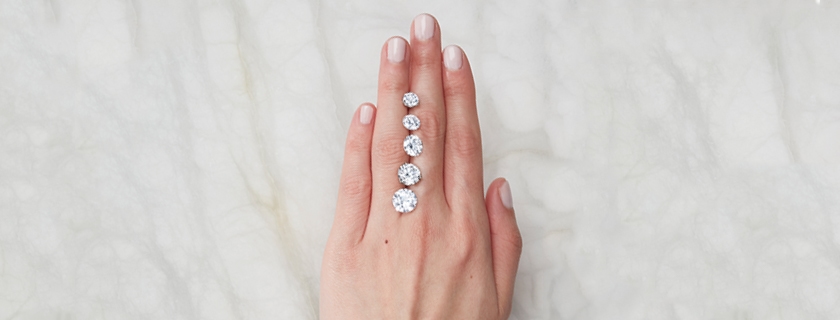
Cut can heavily influence the appearance of a diamond’s size. A diamond with a deep cut has less surface area at the top and too much of its weight is hidden from the eye. Conversely, a diamond with a shallow cut appears substantially larger, but it also lacks the sparkle that gives it beauty. Both would receive a poor grade from the GIA, the premier diamond grading nonprofit. A well-cut, quality diamond will appear larger, while giving off maximum sparkle.
KWIAT STANDARDS
A properly cut diamond will not have too much weight in hidden areas. The added weight increases the cost without giving the diamond a larger appearance. At Kwiat, we refer to this as “the weight being in the right place.” A beautifully cut 2-carat stone will look larger than a poorly cut 2.5-carat diamond because the weight is maintained in the visible portions of the diamond. When comparing diamonds, pay close attention to the millimeter dimensions. Larger carat weight is only worth paying for when it adds to the beauty and visual size appearance of the stone.
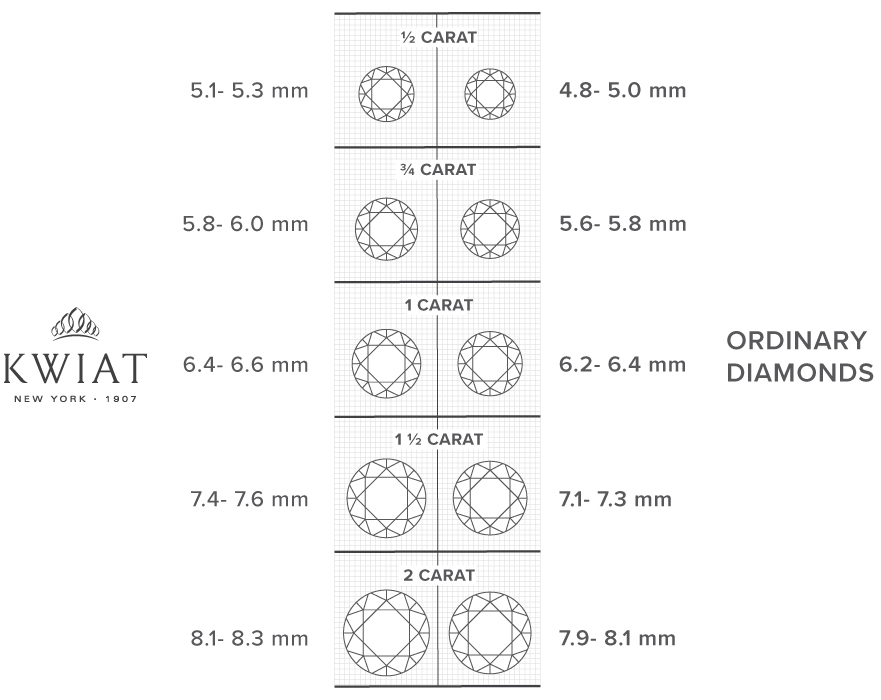
Two diamonds with the same carat weight may appear different because of their shape. Longer shapes tend to appear visually larger than round and square shapes. For example, an oval shaped diamond may appear larger than a round brilliant. If a larger looking size is important, take shape into consideration when exploring a diamond’s carat weight.
CARAT WEIGHT TRADE-OFFS
Increasing a diamond’s carat weight can mean adjusting your color or clarity requirements. That said, we never compromise on the diamond’s cut.
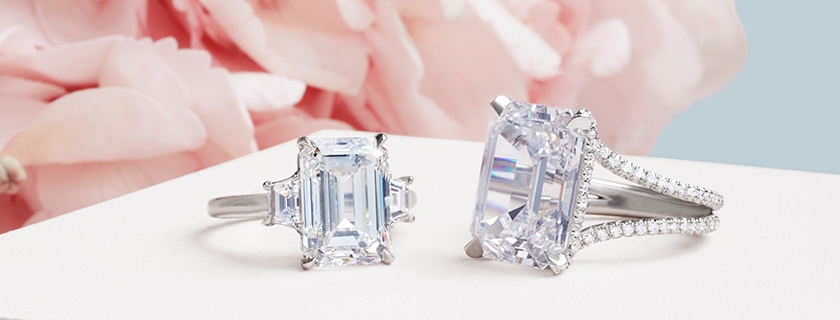
CARAT PRICING
As a diamond’s carat weight increases, so does the cost per carat. This is because higher carat diamonds are far rarer than stones with fewer carats. Since diamonds are typically priced according to tiers such as ½ carat, 1 carat, 2 carats, etc., it is worth searching for a stone that sits just under one of these tiers. For example, a diamond that is 1.99 carats would cost less per carat than a stone that is 2.01 carats.
When looking at a diamond, pay close attention to the millimeter dimensions. More weight does not correlate to a diamond that appears larger. Larger carat weight is only worth paying for when it adds to the beauty and visual size appearance of the stone.

